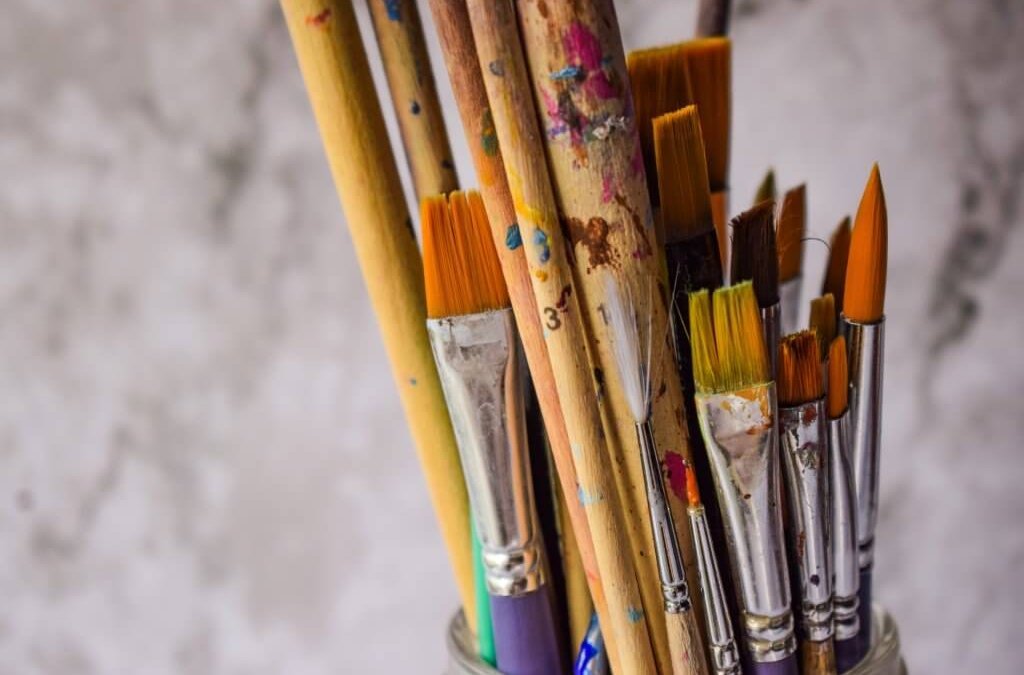Raise your hand if you have never painted with acrylics before!
Even if you have experience painting with another medium (like oils, watercolor, etc.), or you are a beginner, you will enjoy meeting acrylics!
When it comes to acrylics, many artists give an advantage to the acrylics for practical reasons. These are the non-toxic paints, almost without a smell (smells like art if you ask me) and the cleaning after acrylics can’t be easier. Other artists use this technique because of fast-drying, which enables them to continue painting later if they get tired, need to replenish their creativity, etc. My favorite advantage of this technique is that if you are not satisfied with your painting and you want to do a little fix or even to overpaint something new over an old painting, it’s easy to cover and you can start in just a few minutes.
This blog post aims to speed up your time with finding answers to basic questions about this technique, which tools to use, basic terms in acrylic painting, tips, tricks, interesting themes about other world-famous painters, etc.
FIRST AND FOREMOST
First thing first, practice, practice and practice!
Leonardo da Vinci (1452–1519) didn’t become one of the greatest artists of all time overnight. Every skill takes a lot of practice, time and dedication. You can do it!
You will fail sometimes, but you will succeed also. We succeed thanks to our mistakes. The mistake means that you tried. I will quote Bob Ross “We don’t make mistakes, just happy little accidents.” “Talent is a pursued interest. Anything that you’re willing to practice, you can do.”
Except for acrylic paint, brushes, canvas, and water, practice is your best friend here. Let the meeting with acrylics be like meeting a friend. Slowly, without expectations and with fun!
IMPORTANT EQUIPMENT FOR STARTING
One of the most asked questions about equipment is “Do you really need to buy tonnes of paint, brushes, and canvases in the beginning? The answer is no.
Because you are in the meeting phase, don’t run out to buy half the store.
To start, all you need is:
1. Acrylic paint
• White: Titanium White
• Red: Primary Magenta, Quinacridone Red or Alizarin Crimson, Cadmium Red Light
• Black: Mars Black
• Yellow: Primary Yellow, Diarylide Yellow, Yellow Ochre
• Blue: Primary Cyan, Ultramarine Blue, Phthalocyanine Blue
• Orange: Pyrrole Orange or Cadmium Orange
• Green: Permanent Green
• Violet: Dioxazine Purple
2. Palette Knife for mixing colors
3. Brushes (smaller and larger)
• Pointed round brush (#4, #8)
• Flat (#4, #5)
• Liner (#0000, #1)
4. Palette (my recommendation is to buy a plastic box pallet because it is the easiest for cleaning and doesn’t absorb the paint as much as a wooden pallet. If you want to finish your painting later, close the box pallet and paint will be fresh when you start again)
5. Surface (canvas, paper, hardboard)
6. Water
7. Paper towels/ cloth for cleaning
8. Primer for priming
9. Varnish for protecting artwork once it’s finished
Bonus tip: Acrylic paint is well known for fast drying. To prevent that, spray a few drops of water on your pallet and you’ll keep your paint fresh for a longer time.
BASIC TECHNIQUES FOR BEGINNERS
You’ve got your acrylic paint, your work surface is ready, and you’re really inspired to paint. Now comes the fun part: putting paint on paper!
But how exactly do you get started? Here are a few painting techniques you can start with. Free your mind and let your brush and imagination lead you, just start and go for it.
Techniques for paint application:
• Drybrush
• Washing
• Stippling
• Splattering
• Dabbing
• Palette knife
• Detailing
Techniques for building a painting
• Underpainting
• Glazing
• Layering
• Painting in a block of colors
Color mixing techniques
• Partially mix colors before painting
• Create a family of colors
MAKE PAINTING FUN NO MATTER WHAT
One of the main challenges for beginner artists is that the painting does not come out looking like what you had in your head. In the beginning, the final piece is a little bit different from how we imagined it in our head.
There are no mistakes, just happy little accidents. It’s practice, you have to go through a lot of paintings, trying, searching, and thinking. It’s okay for a painting to end up different, that’s how you learn. It takes a lot of brush strokes to be able to plan and know exactly how to render a certain effect.
Don’t get discouraged. Keep painting and don’t forget the most important thing: in painting, the fun is in the journey, not the destination. Even I, after years of painting, have to repeat that quote to myself when I get too hard on myself.
Enjoy every step of painting, even the mistakes, because they teach you how to paint. And remember, if you like it then it’s not a mistake.
THANKS FOR READING
Thanks for taking the time to read this post. I appreciate it! Feel free to share it with friends. If you want more painting tips, come join me at jovanalipovac.com.
Happy painting!




